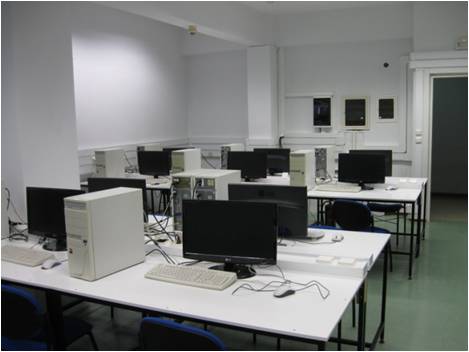
Menu:
Announcements
Teaching

Computers I (104):
Introduction to programming with Fortran. Variables and arithmetic expressions, input/output. Flow control, loop structures.
Arrays. Subroutines, functions.
The course consists of: 4h/week theory, 2h/week labwork
(1st semester, 6 ECTS units)
Instructors: D. Papageorgiou, E. Lidorikis

Computers II (204):
Programming with C++. Variables and arithmetic expressions, input/output, flow control, loop structures, arrays.
Functions, structures, classes.
The course consists of: 4h/week theory, 2h/week labwork
(2nd semester, 6 ECTS units)
Instructors: D. Papageorgiou, E. Lidorikis
Physics II (201):
Electric charge and electric field. Gauss law. Electric potential. Capacitance and dielectrics.
Current, resistance and electromotive force. Constant current circuits. Magnetic fields and magnetic forces.
Origin of the magnetic field. Electromagnetic inductance. Self-inductance. Alternating currents.
Electromagnetic waves. Nature and propagation of light. Geometrical optics. Interference, diffraction.
The course consists of: 4h/week theory
(2nd semester, 4 ECTS units)
Instructor: Ch. Lekka
Quantum Theory of Matter (401):
Quantum theory of light: black-body radiation, photoelectric effect, Compton scattering.
Discrete nature of matter: atomic structure, Bohr atom, atomic spectra.
Material waves: de Broglie wave, Heisenberg uncertainty principle, particle-wave duality.
Quantum mechanics in 1D: wavefunction, operators, Schrodinger equation.
Simple solutions: particle in an infinite quantum well, particle in a finite quantum well, quantum oscillator.
Quantum mechanics in 3D: particle in a 3D quantum well, central forces and angular momentum, hydrogen atom.
Atomic structure: angular magnetic moments, Zeeman effect, electron spin, spin-orbit coupling, magnetic structure.
The course consists of: 4h/week theory
(4th semester, 4 ECTS units)
Instructor: E. Lidorikis
Atomic and Electronic Structure of Solids (506):
Introduction. Basic elements of quantum mechanics. Study of solids within the Jellium model: Jellium model,
basic elements of solid materials, electron motion (wavenumber and Fermi energy). Periodicity and crystal
structure: definitions and theorems, classification of Bravais lattices and complex crystal structures,
reciprocal lattice and Brillouin zones. Introduction to the method of Linear Combination of Atomic Orbitals (LCAO).
The hydrogen molecular ion, ionic bonding (NaCl), and the benzene molecule. The LCAO method in simplistic models of "solids":
infinite one-dimensional elemental "solid", one-dimensional ionic "solid" with one or two orbitals per atom. Semiconductors I:
characteristics, direct and indirect band-gap semiconductors, optical absorption, exitons. Lattice vibrations in a
one-dimensional periodic medium. Coupled oscillators, dispersion relations, vibrations in real lattices, phonons.
The course consists of: 4h/week theory
(5th semester, 4 ECTS units)
Instructor: Ch. Lekka
Electronic-Magnetic-Optical Properties of Materials (601):
Electrical properties of metals. Ohm's Law. Specific conductance and specific electrical resistance tesnsors. Hall Effect. Magnetic resistance.
Maxwell-Boltzmann distribution. Fermi-Dirac quantum distribution. Energy spectral density. Absorption of electromagnetic radiation.
Spontaneous and stimulated emission. Population inversion. Three and four energy level laser systems. Pumping. Optimal power output.
Spectral line broadening mechanisms.
The course consists of: 4h/week theory
(4th semester, 4 ECTS units)
Instructors: D. Papageorgiou, I. Panagiotopoulos, E. Lidorikis
Semiconducting and Dielectric Materials (702):
Crystal structrures of semiconducting materials. Intrinsic and extrinsic semiconductors. Band diagrams. Electron charge transfer. Scattering mechanisms.
p-n Junction. Dielectric Materials. Atomic and molecular dipoles. Polarizability sources. Interactions of dilectrics with electromagnetic radiation.
Optical properties of semiconductors and dielectrics. Dielectric breakdown. Charge transfer through dilectrics quantum effects.
The course consists of: 4h/week theory
(7th semester, 4 ECTS units)
Instructors: D. Papageorgiou, E. Lidorikis
Applications of Information Technology (709):
Software for static and dynamic visualization of atomic and molecular structures using basic principles of
crystallography and of the atomic structure. Basic stages of organizing and preparing a successful oral presentation.
Introduction to Mathematica and solutions to simple problems (integrals, differential equations, curve fitting to
experimental data, 2D, 3D and contour plots, optimization).
The course consists of: 1h/week theory 2h/week labwork
(6th semester elective, 4 ECTS units)
Instructor: Ch. Lekka
Computer Simulation and Design of Materials (810):
Introduction to classical atomistic simulation. Models and interactions. Statistical ensembles (microcanonical, normal), partition function, thermodynamic properties. Molecular dynamics simulation, Newtonian dynamics, equations of motion, phase space. Basic principles of Monte Carlo simulation, the Metropolis criterion. Calculation of structural, thermodynamic and dynamic properties. Time correlation functions. Simulation software and applications in organic and solid state systems.
The course consists of: 2h/week theory 1h/week labwork
(8th semester elective, 4 ECTS units)
Instructor: D. Papageorgiou
Photonic Materials (905):
Electromagnetic theory: Maxwell's equations, constitutive relations. Light propagation in materials:
dielectric function, dispersion and absorption, Drude-Lorentz model. Waves on an interface, reflection and refraction.
Thin films, optical characterization, antireflection coatings. Dielectric mirrors (Bragg), photonic band structure,
photonic cavities, vertical-cavity surface-emitting lasers (VCSEL). Photonic crystals, band structure, waveguides and cavities
in two and three dimensions. Photon confinement: waveguides and optical fibers. Semiconductors: electronic structure,
optical properties, materials systems. Quantum confinement: wells, wires and dots. Structure and materials in light
emitting diodes (LED) and laser diodes (LD). Metals: optical response and properties, surface Plasmon polaritons,
metallic nanoparticles and localized surface plasmons, plasmonic applications. Devices for absorbing and detecting light:
photovoltaic cells, photodetectors.
The course consists of: 3h/week theory
(9th semester elective, 3 ECTS units)
Instructor: E. Lidorikis
Computational Methods for Complex Systems (908):
Local optimization. Optimality conditions. Algorithms and convergence. One dimensional minimization. Ad hoc methods.
Quadratic models. Newton type methods. Conjugate gradient methods. Special methods for sums of squares. Global optimization,
stochastic methods. Optimization software and applications.
The course consists of: 2h/week theory 1h/week labwork
(9th semester elective, 4 ECTS units)
Instructor: D. Papageorgiou
Introduction to Advanced Computational Methods in Materials Science (910):
Introduction to ab-initio quantum computations: Hartree and Hartree-Fock methods, Density Functional Theory, Augmented Plane Wave method,
and to Semi-empirical computations: Tight Binding method and Density Functional Tight Binding method. Applications atomic and electronic
structure computations, as well as of macroscopic properties of periodic systems, biological molecules and nanoscopic materials.
The course consists of: 2h/week theory 1h/week labwork
(9th semester elective, 4 ECTS units)
Instructor: Ch. Lekka